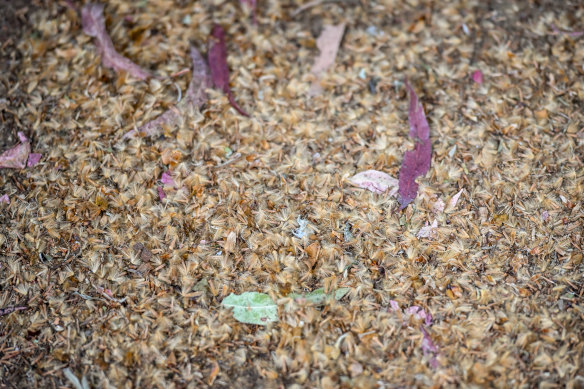It’s spring in the city and that means warmer days, lush greenery and … millions of tiny plant fibres that blow into your airways.
It is, of course, the season of Melbourne’s most polarising plant: the London plane tree.

Voices for Melbourne council candidates Greg Bisinella, Mary Masters and James Vasilev-Robertson.Credit: Justin McManus
Melbourne City Council has a plan to reduce its dominance, but some mayoral candidates for this month’s elections say it is not going far or fast enough.
Having been favoured by planners in the 1980s and 1990s for being hardy and fast-growing, planes – which can reach 30 metres tall – are the most prevalent tree in the CBD, shading many of Melbourne’s most popular streets.
For much of the year, Melburnians admire their mottled trunks and bright, maple-shaped leaves. But in spring, the trees release pollen and fine spiky hairs, called trichomes.
The air swirls with these visible fibres on windy days as people shield their faces or risk a hacking cough.

Plane tree particles piled up on Lygon Street.Credit: Justin McManus
The council’s urban forest strategy plans to remove many of the city’s plane trees, with no one species to account for more than 5 per cent of the municipality’s trees by 2040.
According to new council data, 63 per cent of trees in the CBD are planes, down from 75 per cent a decade ago.
The council is not uprooting healthy plane trees. Instead, it is replacing trees that must be removed due to age or illness.
Across the wider municipality – which includes the suburbs of West Melbourne, North Melbourne, Kensington, Southbank, Carlton, Parkville, East Melbourne and South Yarra – plane trees account for 7 per cent of the total canopy. About 3000 new trees are planted each year.

Masks are frequently worn at this time of year in plane tree-heavy streets.Credit: Justin McManus
Since 2019, the council has removed 449 plane trees and planted 282. The city intends to keep the trees on key streets including Swanston, Bourke, Elizabeth and Collins.
Former councillor and mayoral candidate Jamal Hakim called for a more accelerated approach to replacing plane trees while maintaining important canopy cover. “I personally think it’s not fast enough,” Hakim said.
One of his policies is to spend $25 million on “tactical urbanism” solutions for the city’s most-visited areas, which could involve producing shade using new trees or structures with climber plants.
“Swanston Street and other boulevards are really difficult during spring. We need the right combination of new and existing trees.”
Mary Masters, a council candidate for the Voices for Melbourne group, said there should be a rapid clean-up response to remove plane tree debris from pedestrian-heavy streets to prevent irritants from circulating. She suggested the city’s existing graffiti clean-up resources could be redirected during peak pollen times.
“The fact people having to wear face masks in the street just to get to and from school or the offices, or that people stay home, it can make living here really challenging,” she said. Masters said the current tree-planting strategy was insufficient and she wanted to see more diverse trees planted sooner.
Greens mayoral candidate Roxane Ingleton said she wanted to more proactively replace plane trees as fast as possible while respecting the city’s urban forest. “London plane trees are a highly contentious and divisive issue among the community.”
Plane trees are often blamed for causing hay fever symptoms, but grass-seed pollen – also released in spring – is a bigger culprit. With planes, trichomes are the chief problem, as they irritate people’s nose, throat and eyes.
University of Melbourne professor Jo Douglass, who specialises in asthma and allergic disease, said plane tree trichomes were irritating for a few weeks, irrespective of allergic disease, and then stopped as the weather warmed up.
“It’s a big problem. Many complain as the particles blow about and irritate people. Hay fever due to grasses can occur at the same time so for many it’s especially bad,” Douglass said. She said native trees would be preferable as they shed less. “[Plane trees] probably should go in time, but they can be a beautiful tree.”
RMIT sustainability and urban planning professor Sarah Bekessy said plane trees were a “biological desert” and should stop being planted altogether to make room for local species.
“We don’t see birds, insects or even possums using them. It’s a total waste of space in terms of biodiversity,” Bekessy said. “We’d be far better off having trees that provide not just shade but provide biodiversity but also don’t aggravate people with allergies. The coughing fits are dreadful.”
A council spokeswoman said London plane trees provided valuable shade and cooling.
Arron Wood, a former deputy lord mayor now running for lord mayor, said he did not have immediate plans for plane trees if he won, and that he supported the long-standing council policy. “As someone who experiences hay fever, I understand this can be a frustrating time of the year,” he said.
Incumbent lord mayor Nick Reece also said he had no plans to change the strategy.
The Morning Edition newsletter is our guide to the day’s most important and interesting stories, analysis and insights. Sign up here.